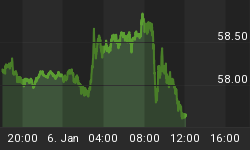The crowing over last month's rise in multi-family starts is over (or at least it should be over).
Here's a September recap, followed by this month's surprise to the downside.
- In September starts jumped 6.5% led by multi-family starts which surged 18.3%.
- Single-family starts were up 0.3%.
- See Housing Starts Surprise to Upside Led by Multi-Family, Permits Surprise to Downside for more details.
Housing Starts Plunge 11% to 7-Month Low
October wiped away all of September's good news and then some with an extremely weak 1.060 million (SAAR Seasonally Adjusted Annualized Rate) coupled with aggregate lower revisions to September data.
1.060 million starts was far below Econoday Consensus Estimate of 1.162 million SAAR and also well below the lowest estimate of 1.125 million.
Pulled down by a big drop in multi-family homes, housing starts fell a steep 11.0 percent in October to a 1.060 million annualized rate that is far below Econoday's low estimate. Starts for multi-family homes, which spiked in September following a springtime jump in permits for this component, fell back 25 percent in the month to a 338,000 annualized rate. Single-family starts fell a much less severe 2.4 percent to 722,000.
And there is important good news in this report. Permits are up, rising 4.1 percent to a 1.150 million rate that hits the Econoday consensus. Single-family permits are up 2.4 percent to a 711,000 rate with multi-family up 6.8 percent to 439,000.
Housing completions fell back in October, down 6 percent to a 965,000 rate that reflects lower work in the Northeast and Midwest. Homes under construction rose 0.9 percent to a recovery best 938,000 rate and are up a very strong 16.4 percent year-on-year, pointing, despite the slip in starts, to ongoing strength for construction spending, at least for October.
But the big drop in starts is definitely a negative for the near-term construction outlook, though the rise in permits points to subsequent strength.
Hidden Strength?
Bloomberg points out "important good news". Let's sort out the reality.
- Last month permits were down 5% this month they are up only 4.1%.
- last month's starts were revised lower from 1.206 million to 1.191 million (a 15,000 -1.24% negative revision)
- Last month's permits were revised up whereas permits were revised higher, to 1.105 million from 1.103 million, but that is only a positive revision of 2,000 and it's on activity that is not even taking place.
Temporary Setback
Using similar analysis as Bloomberg, Reuters writer Lucia Mutikani says U.S. Housing Starts Hit Seven-Month Low; Setback Seen as Temporary.
U.S. housing starts in October fell to a seven-month low, weighed down by a steep decline in the construction of multi-family homes, but a surge in building permits suggested the housing market remained on solid ground.
Rapidly rising household formation, mostly driven by young adults leaving their parental homes and a strengthening labor market, is supporting the housing sector.
Economists had forecast housing starts dropping to only a 1.16 million-unit pace last month. Many viewed the weakness in October as being related to land and labor shortages, constraints that have been flagged by home builders.
"Structural issues including a shortfall in immigrant labor are inhibiting construction. The supply shortage in the single-family market is not likely to be alleviated any time soon," said David Nice, an economist at Mesirow Financial in Chicago.
Labor Shortage?
If there is a shortfall in labor, how come it did not affect last month? I suppose one could say last month's surge caused this month's labor shortage, so let's investigate that idea in pictures.
Pay particular attention to the third chart below that shows single-family construction below the average in the 1960s!
Permits, Thousands of Units
Permits, Percent Change From Year Ago
Single Family Starts, Thousands of Units
Single Family Starts, Percent Change From Year Ago
Questions
Am I alone in failure to see the "important good news" as well as the alleged "rapidly rising household formation, mostly driven by young adults leaving their parental homes."?
Is Mutikani reading Bloomberg on permits, scripting the NAR on housing shortages and household formations, or did she arrive at those conclusions on her own?
Women Not Leaving the Nest
For another perspective on nesters not leaving the nest, please see Women Not Leaving the Nest in Record Numbers; Marriage and Kids, Who Can Afford Them?




















